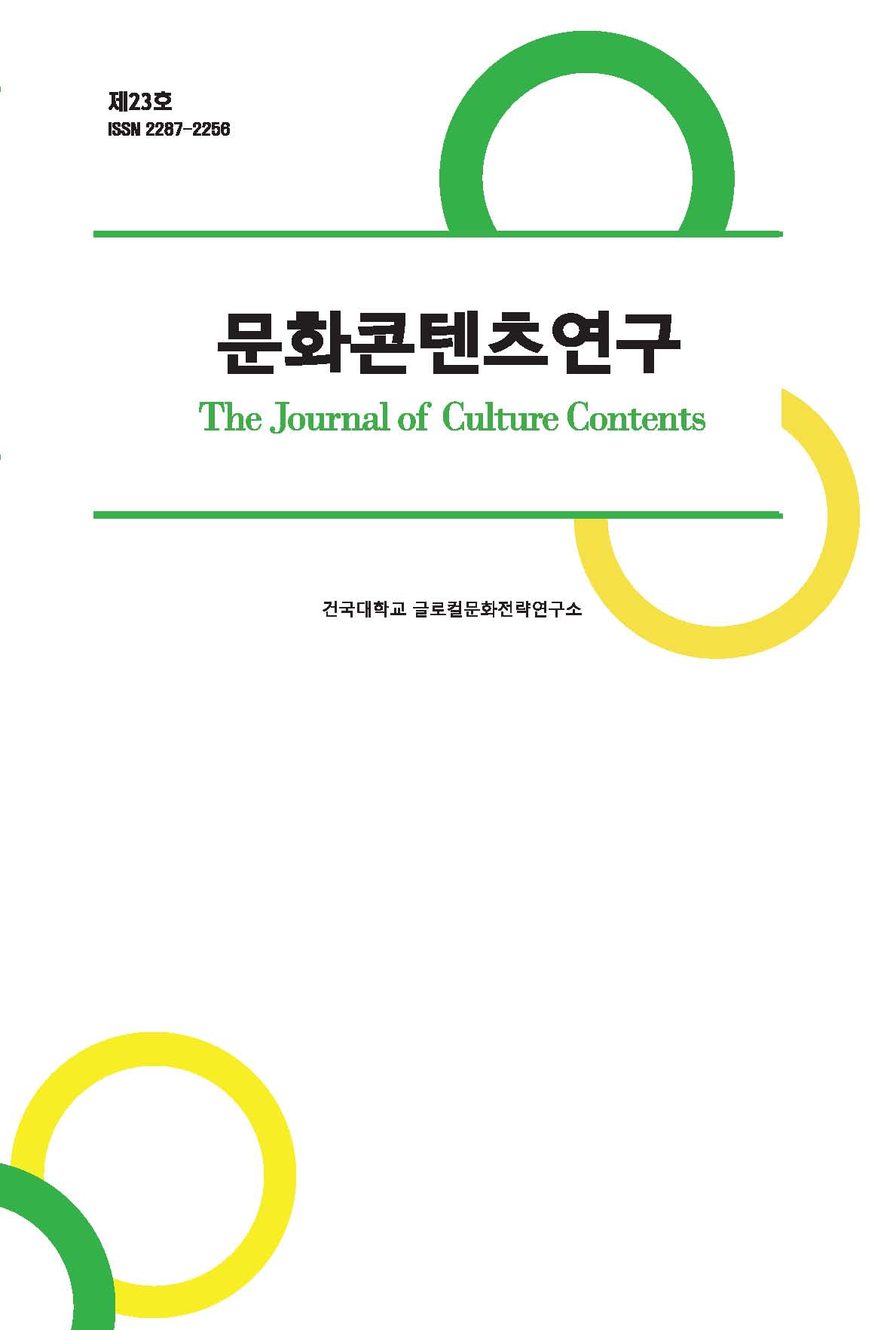Research Article
Abstract
References
Information
This study attempted to analyze the main characters of the JTBC drama in a tri-origin method. Tri-origin means ‘Hetero’ which is the power to change, ‘Homo’ which is the power to remain unchanged, and 'Neutro' which is the power to make it exist properly. And here is another concept of Neutro as “the spirit of existence” that helps the Newtro character to exist correctly. The tri-origin character analysis method is to analyze the character by substituting these tri-origin concepts into the characteristics of the character. When looking at the characters in the work as a family unit, Han Seo-jin’s family, Noh Seung-hye’s family, Jin Jin-hee’s family, Lee Myung-ju’s family, and Kim Joo-young’s family can be classified as hetero characters who adopt any way and any means available for helping their children succeed in the entrance exam. On the other hand, Lee Soo-im’s family and Kim Hye-na’s family can be seen as the Homo character that pertains to the opposite of them. Neutro, who works in the first half of the families within the Castle, feel uneasy about the success of the entrance exam. This may turn into a false neutro, called blind competition for the entrance exam, or it may be established as a correct neutro of learning and growth. The Neutro value view of humanity and family love finally achieved can only be achieved when the characters receive the right help of Neutro.
Individual family members can be classified into the tri-origin characters with a focus on the mother character: Han Seo-jin devoted to success in the entrance exam regardless of the means and methods; Roh Seung-Hye, who wishes for success in the entrance exam but is worried about the dissolution of his family; Jin Jin-hee, who struggles between the success of the entrance exam and the harmony of his family; Lee Myung-joo, whose family is disintegrated though she helps her child succeed in the entrance exam by adopting every way and means available; Lee Soo-im, who knows the value of learning and growth and designs the future with his child; and Kim Joo-young, who spreads his failure to other mothers as it is, and fall.
They have undergone key events and acquired the Neutro character through awakening and maturity that complement their characters with the characteristics of opposite characters. is a huge drama composed of 20 episodes, but it can be confirmed that it is valid in that it can present the core of the story concisely and accurately through a tri-origin methodology.
본 연구는 jtbc 드라마 의 주요 인물을 삼원론적 방법으로 분석한 글이다. 삼원은 변코자하는 힘의 ‘헤테로(Hetero)’, 변치 않고자 하는 힘의 ‘호모(Homo)’, 올바르게 존재케 하는 힘의 ‘뉴트로(Neutro)’를 의미한다. 여기에 올바르게 존재케 하는 뉴트로 캐릭터를 돕는 ‘존재 정신’으로서의 뉴토(Neutro) 개념이 하나 더 있다. 뉴트로가 현실 세계의 뉴트로라면, 뉴토는 존재 세계의 뉴트로라고 할 수 있다. 따라서 크게 헤테로, 호모, 뉴트로로 보아 삼원으로 표현한다. 이러한 삼원의 개념을 캐릭터 특성에 대입하여 분석한 것이 삼원론적 캐릭터 분석 방법이다.
에 등장하는 캐릭터를 먼저 가족 단위로 분류해보면 한서진 가족, 노승혜 가족, 진진희 가족, 이명주 가족, 김주영 가족을 자녀의 입시 성공을 위해 수단과 방법을 가리지 않는 헤테로 캐릭터로 분류할 수 있다. 반면에 이수임 가족, 김혜나 가족은 이들과 반대되는 호모 캐릭터에 해당한다. 캐슬 내 가족들에게 초반에 작용하는 존재 정신으로서의 뉴토는 ‘입시 성공’이다. 이것은 자칫 맹목적 입시 경쟁이라는 ‘잘못된 뉴토’로 변질될 수도 있고, 배움과 성장이라는 ‘올바른 뉴토’로 정립될 수도 있다. 최종적으로 달성하는 인간애‧가족애라는 뉴트로 가치관은 캐릭터들이 올바른 뉴토의 도움을 받을 때 비로소 달성할 수 있다.
개별 가족은 그 속에서 다시 각각의 인물을 삼원으로 분류할 수 있다. 즉 수단과 방법을 가리지 않고 입시 성공을 위해 달려가는 한서진, 입시 성공을 바라지만 가족 해체를 걱정하는 노승혜, 입시 성공과 가족의 화목 사이에서 갈팡질팡하는 진진희, 수단과 방법을 가리지 않으며 입시에 성공했지만, 가족이 해체된 이명주, 배움과 성장의 가치를 알고 자녀와 함께 미래를 설계하는 이수임, 자신의 실패를 다른 어머니들에게 그대로 전파하다 몰락하는 김주영의 가족 구성원을 다시 삼원 캐릭터로 분류할 수 있다.
작품의 후반부에서 이들 모두는 핵심 사건을 겪으며 반대 캐릭터의 특성을 받아들여 자신의 캐릭터를 보완하는 ‘각성’과 ‘성숙’을 통해 뉴트로 캐릭터로 전환된다. 은 20부작으로 구성된 방대한 분량의 드라마지만, 삼원론적 방법론을 통해 이야기의 핵심을 간결하면서도 정확하게 제시할 수 있다는 점에서 유효함을 확인할 수 있었다.
- 강보라‧김기덕, 「SBS 드라마 <녹두꽃> 캐릭터 분석」, 『영상문화』 제37호, 한국영상문화학회, 2020. 10.21299/jovc.2020.37.10
- 김기덕, 「삼원론을 활용한 캐릭터분석-영화 <노인을 위한 나라는 없다>를 중심으로」, 『인문콘텐츠』제29호, 인문콘텐츠학회, 2013.
- 김기덕‧김설아, 「빅토르 위고의 『노트르담 드 파리』 OSMU 연구: 캐릭터의 변화를 중심으로」, 『영상문화』제34호, 한국영상문화학회, 2019.
- 김진영, 「드라마 <스카이캐슬>에 나타난 교육사회적 욕망의 구조: 르네 지라르의 욕망의 삼각형이론을 중심으로」, 제주대학교 교육대학원 석사학위 논문, 2020.
- 김의준, 「영화 <기생충>의 기택 가족을 통해 본 인물의 성격 유형과 캐릭터 아크 라이(LIE)의 상호 연관성 연구」, 『영상기술연구』 제34호, 한국영상제작기술학회, 2020.
- 남미자 외, 「교육열, 능력주의 그리고 교육 공정성 담론의 재고(再考): 드라마 <SKY 캐슬>의 담론 분석을 중심으로」, 『교육사회학연구』 제29권 제2호, 한국교육사회학회, 2019.
- 안명숙, 「가족 위기 드라마에 대한 수용자의 반응연구 - TV드라마 <스카이캐슬>텍스트에 대한 소셜 빅데이터 분석 중심으로-」, 『문학치료연구』 제56집, 한국문학치료학회, 2020.
- 안숭범, 「한류 스토리콘텐츠의 캐릭터 유형 및 동기화 이론 연구 - 한류 3.0 시대를 견인할 스토리 기획창작 모델 개발」, 『경제인문사회연구회 인문정책연구총서』, 경제인문사회연구회, 2018.
- 유현미, 『SKY 캐슬 1』, 위즈덤하우스, 2019.
- 유현미, 『SKY 캐슬 2』, 위즈덤하우스, 2019.
- 정민승, 「스카이캐슬 읽기:입시 정체성에 대한 후기구조주의적 접근」, 『교육비평』 제43호, 교육비평, 2019.
- 한귀은, 「TV드라마 <SKY 캐슬>에 나타난 욕망응시주체화」, 『국어교육』 제165권, 한국어교육학회, 2019. 10.29401/KLE.165.10
- 교육부, 행복한교육 4월호, 2018, http://happyedu.moe.go.kr/happy/bbs/selectHappyArticleImg.do?bbsId=BBSMSTR_000000000192&nttId=8266
- 「강남 서울대 입학, 강북 21배…'SKY 캐슬'은 현실이었다」, 『중앙일보』, 2019년 2월 23일자, https://news.joins.com/article/23393931
- 「[공식] 'SKY 캐슬' 2020 아시안텔레비전어워즈 작품상…"가장 사랑 받은 亞드라마"」, 『조선일보』, 2020년 1월 13일자, https://www.chosun.com/site/data/html_dir/2020/01/13/2020011301425.html
- 「유은혜 교육부 장관 "SKY 캐슬, 과도하지만 현실 반영"」, 『중앙일보』, 2019년 1월 7일자, https://news.joins.com/article/23268767
- 닐슨미디어리서치, http://www.nielsenkorea.co.kr/
- <SKY 캐슬> JTBC 드라마, 2018, 프로그램 홈페이지 https://tv.jtbc.joins.com/plan/pr10010969
- Publisher :Research Institute of Creative Contents
- Publisher(Ko) :글로컬문화전략연구소
- Journal Title :The Journal of Culture Contents
- Journal Title(Ko) :문화콘텐츠연구
- Volume : 22
- No :0
- Pages :101-160
- DOI :https://doi.org/10.34227/tjocc.2021..22.101



 The Journal of Culture Contents
The Journal of Culture Contents





